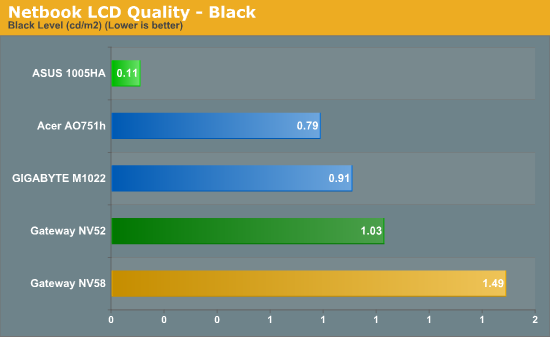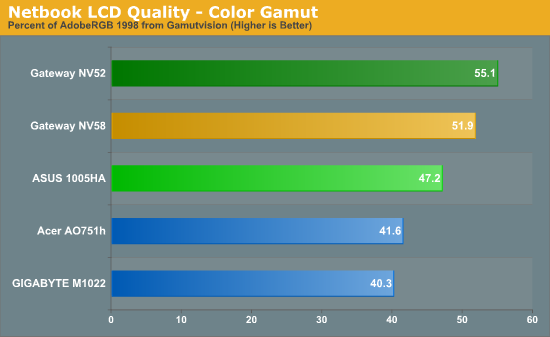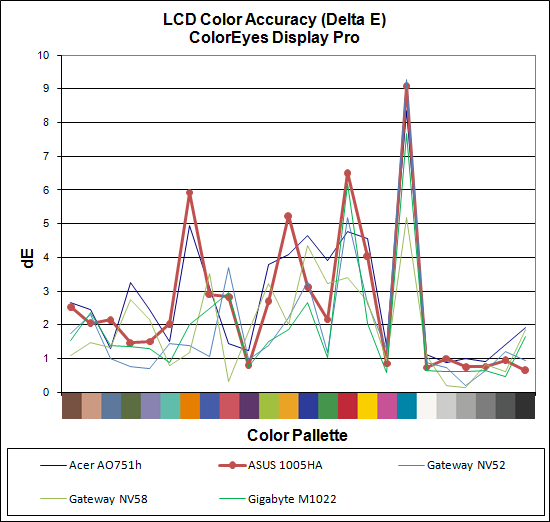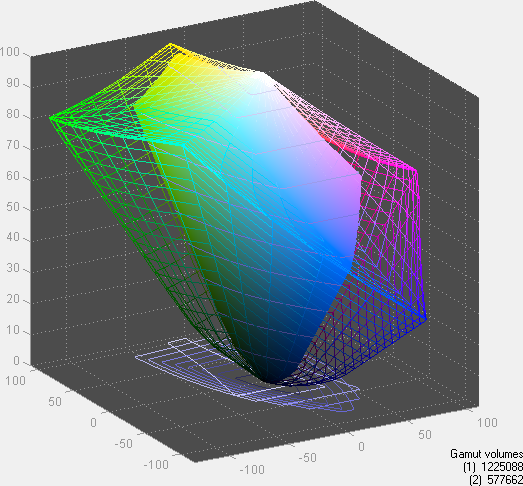ASUS Eee PC 1005HA: Refining the Netbook
by Jarred Walton on August 20, 2009 4:00 AM EST- Posted in
- Laptops
Netbook LCD Quality
One of the things we immediately noticed with the 1005HA is that the LCD looked a lot better than other laptops we've tested recently. We ran our standard LCD quality tests using ColorEyes Display Pro to investigate further. It's not the best LCD we've ever seen in a laptop -- not by a long shot -- but compared to competing netbooks the LCD certainly has some strong points.







The reason this display stands out so much from the crowd becomes immediately obvious: the contrast ratio is significantly better than any of the other netbooks we've looked at (and better than any notebook we've looked at for that matter). Contrast ratio isn't everything, but a high contrast ratio helps to avoid the washed out look we've seen on a lot of laptop LCDs lately.
The other aspects of the LCD panel aren't quite as impressive. Color accuracy is typical of most laptops, as is the color gamut. Maximum brightness is also quite dim, at just 128 nits. Combined with a glossy LCD, the low maximum brightness is something that works well indoors but will definitely present problems outdoors. If you're hoping to carry this netbook around campus and work outdoors in the commons during nice weather, you'll probably be disappointed. We'd like ASUS to boost the LCD brightness 100% (~250 nits) while maintaining the high contrast ratio, but ASUS is at the mercy of the LCD panel manufacturers. Increasing the brightness could also reduce battery life if not done properly -- even at the same 100 nits we use during testing, it's clear that not all LCD panels are created equal.
Looking at two netbooks side-by-side, i.e. the 1005HA and the M1022, the high contrast ratio makes the 1005HA look brighter than it actually is. This is part of the problem with trying to match brightness levels without using a colorimeter, and it's why we use such tools to equalize our battery life tests. For indoor use like in a home, office, or classroom, the panel on the 1005HA is noticeably better than other laptops and netbooks. We just wish it had a brighter LED backlight.
Update: As one reader pointed out, the modding community has created a utility called "EeeCTL" that allows you to tweak the backlight brightness. Using the "Ultrabright" setting the LCD will run at ~250 nits while maintaining a 1000:1 contrast ratio. Power requirements will increase quite a bit at that brightness (over 2W, which is ~33% more at idle and ~25% more in Internet use), resulting in much lower battery life, but it is a nice option for when you're working in environments that benefit from brighter LCDs. You should still be able to get around 6 hours of battery life at 250 nits while surfing the web.










41 Comments
View All Comments
Mugur - Friday, August 21, 2009 - link
I have an Acer Aspire One 150 from last year (N270, 1.5 GB RAM, 120GB harddisk) and I must say that the "slowness" is far less noticed than some may think. I tested with XP Pro, Vista Ultimate and now I have Windows 7 Ultimate RC on it. If you keep it clean and with some trivial optimizations (turn off system restore etc.) it performs fairly nice on tasks like browsing, Office, even movies.Some "myths" like not supporting Aero, or 720p video are false. It plays nice with Aero and using Vista's or 7 included video drivers I can play 720p with no dropped frames up to a certain bitrate. I tested with the wmv 720p clips from MS site and also with x264 encoded MKV files - the catch is to use Media Player Classic and CoreAVC codec (smt support). Files around 1 GB for a TV show (40 minutes) or up to 4-6 GB for a full length movie are 100% playable.
I have also an old CeleronM 1.73 Ghz notebook with 2 GB RAM and 120 GB 7200rpm hdd and, side by side, the Atom doesn't feel slower. The benchmarks are "true", but I think that they are not painting the real picture: for light tasks and with a "clean" OS and not a bunch of start up applications :-) netbooks are perfectly usable.
JarredWalton - Friday, August 21, 2009 - link
You are apparently correct; CoreAVC ($15) allows you to decode x264 720p videos. CPU usage looks to be around 70%, give or take. I'll run the battery test to see how it fares under that load and update the text.Codesmith - Thursday, August 20, 2009 - link
At your desk you hook it up to a 24" LCD, POWERED usb hub that connects to an external optical drive, keyboards, mouse, printer, and plug it into your speakers and you are good to go.When you are not at your desk its small, lightweight and has insane battery life.
Even though I have a powerful gaming desktop and a 13" Macbook I loved the netbook, I just can't justify the purchase.
If I was a student, or traveled a lot I'd buy one in a heart beat.
ashegam - Friday, August 21, 2009 - link
regarding the browser size comparison (dots)you can rearrange firfox to display your buttons, File menu and address bar all in one line (bar). Add "addblock" to it you should have the most browsing real estate then all the other browsers.
JarredWalton - Friday, August 21, 2009 - link
With the customizations you mention and with "small icons", Firefox is still *slightly* larger than Chrome. But I do like having menus. Of course I was going off of default settings, and AdBlock is an add-on... going there would open up a large can of worms. The basic comments still stand, however: the 600 pixel height is a real issue with netbooks and web pages. Honestly, even 768 or 800 is too short. It's on reason I miss the old 5:4 1280x1024 displays.GeorgeH - Thursday, August 20, 2009 - link
This review suffers from the same thing 95% of Atom/Ion/Nano and other low-end performance reviews suffer from: too many benchmarks and not enough subjective impressions.I already know it's pitifully slow. I already know it can't do HD video. I already know it can't game. What I don't know is how painful it is to use doing the basic tasks it was designed for, and when it starts to choke and become annoying.
This criticism isn't as critical for Netbooks, but if you ever do a Nettop review (especially for one designed as an office light-use low-power desktop replacement) subjective usage impressions under different types of typical workloads would be orders of magnitude more helpful than yet more graphs.
bigkah624 - Thursday, August 20, 2009 - link
Ditto what GeorgeH said. A netbook is for easy portable net browsing and document-editing on a usable screen. If you want a powerful netbook, then pay for it. Dont expect to spend sub-$400 (not yet anyway) and still expect all the sweet things most commenters are asking for here. If you want a powerful little box, go look at Sony's VAIO TT. And yes, expect to pay for it. Dearly.JarredWalton - Thursday, August 20, 2009 - link
George, when we don't run the additional tests, people complain. Your own statement already sums up the situation: it's pitifully slow... compared to any modern PC. These netbooks are as fast as single-core 1.2GHz Pentium M Centrino laptops from about 2003. Plenty of people still use such laptops for office tasks, though.Subjectively, you *know* the netbook is slow when you use it. Launching Internet Explorer (or Firefox, Chrome, Opera, or Safari for that matter) takes noticeably longer. Opening and rendering web pages takes noticeably longer. Interacting with Windows in general is far more sluggish. I included the detailed PCMark05 results for a reason, because they explain in numbers exactly what you'll experience with a netbook. An entry-level $500 laptop is about 50% faster at rendering *simple* web pages. Loading up AnandTech.com in IE takes around 3.5 seconds per page compared to 2-2.5 seconds. MS Office will load slower and take a bit before you feel it reaches full responsiveness (maybe 10 seconds or so).
Does any of that qualify as choking and being annoying? Relative to a really fast system, perhaps, but for $300-$375 I don't think so. Don't run tons of web pages in tabs, don't open eighteen applications at once, and you'll be fine. I don't know what you want me to say subjectively that isn't already conveyed by the performance charts. It's slow, but it's "fast enough".
The most annoying aspect for me continues to be the low resolution LCD. It's at its best in movies, and everywhere else I wish I had a larger, higher resolution LCD. However, it will suffice for normal office use. Note also that most web pages aren't designed for optimal viewing on a 1024x600 LCD panel - the majority don't have a problem with the width, but the height is a real issue so expect to do a lot of scrolling. IE8 (or Firefox) with the address bar, menu, tabs, and status bar uses 150 pixels. The task bar is another 30 or so (unless you hide it). That's one third of the vertical space without any useful content! Most web sites then put a ~130 pixel site banner at the top, and perhaps some other stuff. For instance, our site is 330 pixels before you even see the articles on the home page and 600 pixels to the article text when reading an article. It's why the touchpad gestures are useful, because you'll do a lot of scrolling.
Hope that helps... maybe I'll update the conclusion.
GeorgeH - Thursday, August 20, 2009 - link
That helps. Part of the problem is that in the past 4+ years I haven't spent any real time with anything much slower than a high end Prescott, so I have a hard time visualizing what scores as low as the Atom's really mean or "feel like" in practice.After thinking about it more, I guess I'm really asking what types of users and what types of tasks you think Atom/Nano platforms would be acceptable for, purely from a performance perspective and beyond the obvious ones such as a 12th PC or simple fileserver. I realize that's a very difficult and highly subjective question to answer, but that's why you get the big fat paycheck, right? ;)
One scenario that might help explain what I'm trying to get at:
Imagine yourself as the head of IT for a large, multinational corporation (one that only uses mainstream applications.) The CEO wants to "Go Green" and replace as many PCs as possible with low power Atom/Nano boxes without negatively impacting productivity or morale. How many new PCs do you buy (if any), and for whom?
yyrkoon - Thursday, August 20, 2009 - link
Well, I know you did not address me, but I would like to add on things that I feel Jarred left out.First, I have helped a couple of friends do the initial OEM setup on XP netbooks, and they are dog slow. Boot up on these Dell netbooks takes what seems like forever, just to enter into the the welcome/setup screen. Probably around 1.5-2 minutes for first boot. Then going through the different setup pages for the various things such as computername, and network setup are very sluggish compared to say a doing the same on a Pentium 4 onward. Honestly, I have installed XP Pro on a PII 300 with 384 MB of RAM, and I do not think it was this slow( it was a few years ago ). This I would have to assume would have to do with HDD speeds but I am not 100% sure. In relation again to your Prescott onwards comment, I would have to say if you're not very patient, you would probably get upset waiting to do things, or perhaps start reading a book, or doing something else ( cook dinner ? Yes, exaggeration ). I myself got very frustrated just navigating around in XP home on these two Dell mini's, but I am not exactly patient. For someone else who has little experience with reasonably updated Windows system, they would probably be happy. *Until* they try and do something like play a game other than minesweeper, or tried using Photoshop, etc.
On the flip side of things, the atom classed CPU's would make for a fairly decent embedded system CPU. But only for certain applications, and definitely not in netbook form. unless perhaps a developer was using one for the development stages for some reason.
In your scenario where you may have a CEO who wants to "go green", there are better options. One could consider buying a specific motherboard with the ability to undervolt/underclock the system, and pay someone to set this up in the BIOS. George Oui ( last name correctly spelled ? ) from ZDNets tech article section ( before he left ) seemed to have done some very intensive/hands on testing of some of the lower power rated Core 2 Duo CPU's, and was able to to achieve ~50W for a single system including a LCD monitor ( full load ). That is definitely not bad for a desktop classed system, but you could do better with laptop classed parts in a mini ITX system ( which are available ), but at a comparitively higher price. All in all however, it would probably be better to contact an OEM vendor such as Dell, tell them what you need, and see if they can build something to meet your needs.
As for the testing . . . I do not see what they could do really. Well, other than what they have done except perhaps include system boot times. Only the odd "current" titled games such as WoW will play on these, and even on the ION platform, are terrible compared to any desktop system made within the last 5-6 years ( assuming said parts were current at the time ).